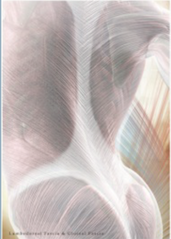Fascia By Any Other Name
Connective Tissue is an umbrella term for all of the various fascia in the body.
Fascia has nothing to do with fascism!
Science is still debating the official name and defining characteristics of fascia.
Fascia by any name will always be the secret to health and longevity.
Fascia has nothing to do with fascism!
Science is still debating the official name and defining characteristics of fascia.
Fascia by any name will always be the secret to health and longevity.
Fascia Defined
Fascia is a united, single structure despite its multiple architectural forms and ability to be everywhere at once. It is also intelligent and facilitates communication. That makes it an organ system, and one that none of our other tissues and organs could exist without.
The fascial system could be compared to today's Internet: A global web intelligently connected to everything, communicating both wired and wirelessly. And just like the World Wide Web - and the feminine side of nature - the quality, purity, and integrity of our fascia and its connections matter the most to our well being!
The fascial system could be compared to today's Internet: A global web intelligently connected to everything, communicating both wired and wirelessly. And just like the World Wide Web - and the feminine side of nature - the quality, purity, and integrity of our fascia and its connections matter the most to our well being!
In A Nutshell
Paula discovered that shifting focus from muscle-soothing toward fascia-clearing resulted in dramatically improved client outcomes. Similar to our sinuses, pockets within fascia can become inflamed, dehydrated, or congested. Congestion comes in many forms, including secondary scar tissue, adhesions, crystalizations, and bone spurs. When we blow our nose clear, we feel better, right? Well, Paula knows how to "blow the nose" of the fascia, and people feel better. And in most cases, it doesn't matter how long the congestion has been there, it can be "melted" and "moved" with the right nuance of techniques. Yes, it is that simple. Simple and complex, both.
Therefore, Paula's massage therapy is actually Fascia Therapy.
Therefore, Paula's massage therapy is actually Fascia Therapy.
- It feels different.
- It lasts significantly longer.
- It is often inadvertently curative.
Methods
Fascia's multiple forms and the varying kinds of congestion, require different debris-clearing methods depending on circumstances. Paula customizes the following methods, elevating them in innovative ways to be more efficient and effective:
- Palpation and treatment via traditional manual therapies like: Swedish massage, Neuromuscular (NMT), connective tissue therapy, Reflexology, and sometimes even Shiatsu
- Vibrational therapies like Tok Sen (hammer massage) and BioSyntonie (subatomic) and others TBD
- Gua Sha (gentle, smooth, strategically repetitive scraping)
- Massage Cupping (non-static vacuum therapy by machine, which brings a vibrational aspect to cupping)
Modern vs. Ancient Methods
Modern methods are fine, but often the ancient ways work better.
Paula evaluates all methods to discover their underlying principles, then enhances their use based on those principles combined with her knowledge of fascia. This evaluation cannot be done through traditional reductionist science - that only works with complicated problems. Health problems are complex, not complicated. Solving complex problems means understanding the simplicity underneath, first. The ancients focused simply on what worked, but became dogmatic in their imagined stories about how they worked. Paula encourages modern scientists to dismiss the dogma and get to work discovering the true mechanisms of ancient methods, so that more people can be helped.
Paula evaluates all methods to discover their underlying principles, then enhances their use based on those principles combined with her knowledge of fascia. This evaluation cannot be done through traditional reductionist science - that only works with complicated problems. Health problems are complex, not complicated. Solving complex problems means understanding the simplicity underneath, first. The ancients focused simply on what worked, but became dogmatic in their imagined stories about how they worked. Paula encourages modern scientists to dismiss the dogma and get to work discovering the true mechanisms of ancient methods, so that more people can be helped.
Muscle vs. Fascia
Traditional massage, physical and sports therapy, and most fitness programs continue to focus on muscles, and that's exactly why they don't get the sometimes other-worldly healing results of the fascia-oriented therapies. When we shift gears and see muscles for what they truly are: workhorses that are too often already overworked, it wisely changes the bodywork conversation for the better. Our muscles, just like all our organs, glands, vasculature, etc. are highly dependent upon the quality and integrity of their support structures: their associated fascia. IOW: The healthier the fascia, whether superficial or deep, the healthier everything else. That makes our connective tissue a lot more important than what most doctors and clinicians are taught: as if it were inert wrapping paper.
The Missing Link in Bodywork Education and Practice
When we switch focus from muscles to connective tissue, we exit the realm of healing by relaxation (which is marvelous for emotional issues, but offers only temporary relief from more physical issues,) and enter the fascinating and complex world of healing by clearing obstructions (congestions, adhesions, stuck inflammations, sharp calcifications, and metabolic crystallizations) in the connective tissue, which is responsible for supporting all systems of the body. The science is new ... but the clinical work is old for those who explore beyond muscle indoctrination.
Applying logic, removing a fascial obstruction is not much different than removing a stubborn clog from a drain pipe: The waters flow on their own. In this case, any blood, lymph, or plasma-like fascial fluids that were slowed, stuck, or congested are more free to flow, allowing the body's own immunity to restore overall health and wellness. Our bodies do not contain inert pipes, however. Over time, the fascia will find and create detours that may lead to compensations that start a slow domino-effect to pain and limited range-of-motion. Circulation-wise, if unable to detour, localized edema may result.
There’s no magic in this. It’s fluid engineering within a closed system under pressure, something we need science to start studying in live tissues, so that no one has to make up analogies to help explain mechanisms!
Applying logic, removing a fascial obstruction is not much different than removing a stubborn clog from a drain pipe: The waters flow on their own. In this case, any blood, lymph, or plasma-like fascial fluids that were slowed, stuck, or congested are more free to flow, allowing the body's own immunity to restore overall health and wellness. Our bodies do not contain inert pipes, however. Over time, the fascia will find and create detours that may lead to compensations that start a slow domino-effect to pain and limited range-of-motion. Circulation-wise, if unable to detour, localized edema may result.
There’s no magic in this. It’s fluid engineering within a closed system under pressure, something we need science to start studying in live tissues, so that no one has to make up analogies to help explain mechanisms!
Paradigm Shift
|
Telling people that manual therapy should be about connective tissue and not muscles, sounds as heretical as any new concept before it's accepted. Thankfully, devoted scientists and clinicians throughout the world are working to mainstream the benefits of understanding and respecting the connective tissue of the body. For an example of their wonderful work, set aside some time for this awesome video.
|
|
The case of the groin pull that was not, and other pseudo muscular pains
The clearest example of how connective tissue issues can mimic muscle pain is in the case of the pregnant and near birthing client who presented with a pulled groin (adductor) muscle. Noticing through palpation that there was "congestive clotting" within the superficial connective tissue in the same hip, but opposite of the pain and on the other side of the hip joint, Paula set about clearing that congestion, and the groin pull pain disappeared! It was an unexpected and most pleasant surprise.
A common example of pseudo muscle pain (and pseudo arthritic pain) comes from crystallizations where tendons attach on the bone - whether at the joint or on the body of the bone. The condition is called calcific tendonitis, and it is difficult for medical professionals to diagnose except in the shoulder, and only when it is severe enough to show up on x-ray. Paula, however, is able to palpate for these crystals almost anywhere in the body, break them down without doing harm, and voila! The muscles automatically relax and let go!
A common example of pseudo muscle pain (and pseudo arthritic pain) comes from crystallizations where tendons attach on the bone - whether at the joint or on the body of the bone. The condition is called calcific tendonitis, and it is difficult for medical professionals to diagnose except in the shoulder, and only when it is severe enough to show up on x-ray. Paula, however, is able to palpate for these crystals almost anywhere in the body, break them down without doing harm, and voila! The muscles automatically relax and let go!
Fascia Research Highlights
Connective tissue cannot be understood through traditional reductive science. The whole must be considered in living tissue and in collaboration with skilled clinicians. Dr. JC Guimberteau, retired plastic surgeon, offered live filming of this brilliant and amazing tissue that inspires all who care about healing the body: Search YouTube for "Strolling Under The Skin." He also wrote a book filled with photos of this tissue: "Architecture of Human Living Fascia." Paula is proud to have been a contributing language editor, without which the book may not have been published, for few understand the depth of this work.
Follow: www.fasciaresearchsociety.org for news of current and future congresses and to support this important research.
Follow: www.fasciaresearchsociety.org for news of current and future congresses and to support this important research.
|
Fascial Manipulation, foreword by Robert Schleip, PhD, Director of Fascia Research Project, Ulm University, Germany. Dr. Schleip summarizes the importance of the body of work by Stecco and Stecco and also talks about why this important tissue has been overlooked for so long.
|
|
|
This video highlights the appreciation of the Stecco family work in both fascia research and clinical application. Paula has worked with Dr. Antonio Stecco in the cadaver lab as his assistant and enjoyed sharing ideas with him. Paula's connective tissue therapy is somewhat similar in results to the Stecco brand of fascial manipulation, both enjoying fast, effective, and longer-term results.
|
AppointmentsRemedial and Prevention Focused
10 AM - 4 PM Advance booking Prepayment Preparation No walk-ins
No same-day appointments No advance or phone consultations No sales or marketing contact FAQPraiseLocationOffice PoliciesAppointment PrepPaula's Massage TherapyProfessional blog |
Repairing the human body since 2003Paula helps your body heal itself through innovative connective-tissue-cleansing bodywork and no-nonsense education.
Specialties Pain & Tension Injuries Arthritis Tendonitis Chronic Fatigue Syndrome (CFS/ME/PEM/SEID) Pain Solutions vs. Pain Management Faster Joint and Injury Recovery Reversal of Premature Aging vs. Anti-aging Prep and Recovery for major life events: eg. surgery, birthing, sports Geriatric Care More Permanent Stress Reduction |
Paula's Body Shop
Paula Mae, LMT Copyright © 2003 - 2024 All rights reserved. The word 'massage' denotes Paula's innovative connective tissue therapies led by expert palpation for noticeable before and after results, and derived from professional training in: Swedish medical massage, Neuromuscular (NMT), Trigger Point, Massage Cupping, Reflexology, Acupressure, Shiatsu, and Smooth Gua Sha. She also employs vibrational therapies from dense to subtle like: Tok Sen (hammer massage) and BioSyntonie.
|


